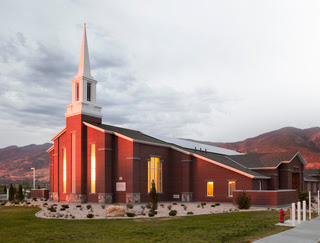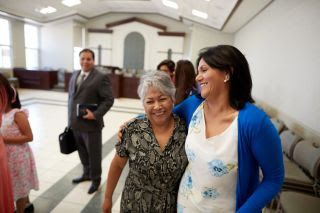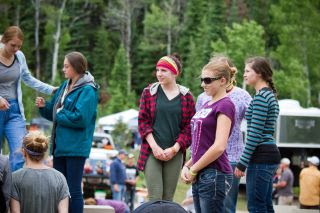 |
| A Farmington, Utah chapel of the Church of Jesus Christ of Latter-day Saints |
From time to time, some ridiculous and completely wrong article about the Church of Jesus Christ of Latter-day Saints comes across my social media feed. I usually ignore them. But sometimes, just to get a laugh at how wrong I know they'll be, I read one.
Here's one that I've decided to pick apart. It's from one of those trashy blogs that exist only for search engines to find and display advertising as you're forced to click "next" 30 times to see the whole article.
I write this so that at least some counter-answer will be available to balance out the misinformation and disinformation about us. Maybe someone searching for these keywords will come here instead of going there. This is, as Paul Harvey's catchphrase goes, "the rest of the story". In most cases, it's a complete refutation.
Before we begin, there are two major overarching themes of these misinformed posts.
1. an inability (or, often, a deliberate lack of attempt) to distinguish principles and doctrine from culture, tradition, or even policies within our faith.
There are many cultural and traditional practices that creep into every organization on the planet that have little to do with or are even antithetical to their core principles. Those are the works of men and women, not God.
The same has happened to us over the two centuries that we've been trying to get these things right as a church. We are human beings, fallible to our core, but nonetheless trying to do things the way the Lord wishes them done. We often fail to listen well. We make mistakes, but the Lord lets us learn through them, teaches us, and lets us try again. If He did not, then we would be forced at every turn to do things exactly as He wishes and all free will would be erased. We would cease to be His children and instead become slaves.
In addition, some policies have arisen to handle situations endemic to certain time periods. They were later rescinded, changed, or replaced. Policies are not first principles nor are they doctrines that are based on principles. They are merely rules established for organizational or transient purposes and are not always perfect.
2. a lack of understanding, or engaging in deliberate misinformation, about the distinction between the Church of Jesus Christ of Latter-day Saints (LDS) and the completely unaffiliated Fundamentalist Church of Jesus Christ of Latter-day Saints (FLDS). I have some experience with the FLDS having grown up only 40 miles from their communities and having been an LDS "stake missionary" sent to help some of them escape and convert to LDS teachings. But that's the subject of another future post.
Most of the error-filled points I am quoting from the article below have a mix of both 1 and 2.
You don't have to take my word for any of the following. I invite you to simply show up to a local Sacrament meeting on any given Sunday and see and ask others for yourself.
From:
"30 Bizarre Mormon Rules You Won’t Believe Are Real"1. Passing the ‘Chastity’ Test
Females as young as 8 and up to the age of 12 are asked questions about their sexual knowledge and, hopefully, the lack of it. A Mormon girl must be as pure and white as the driven snow in order to be a suitable life partner for her future husband. Any known form of previous hanky-panky would deem the girl to be tarnished.
The doctrines of chastity in Abrahamic faiths have been pretty well-established for thousands of years. The most concise expression of the Law of Chastity is that nobody shall have sexual relations outside of legal and lawful marriage between a man and a woman.
So, it should come as no surprise that Latter-day Saints, who profess Christianity (in spite of our detractors' howls to the contrary), also strive to live the Law of Chastity.
Part of doing so requires us to teach that law to our children. This happens primarily in the home, where fathers and mothers are both asked, per their own discretion and methods, and as far as the ability of the child to understand at any given age, to proactively instruct as well as answer questions about what sex is, when it's appropriate, what is appropriate, and how it can bless our lives.
That goes for boys, girls, women, and men alike. Not just girls.
Another part, on a more minimal level, does happen at church. Materials published by the Church in the past have included chapters on the Law of Chastity and still do. Exactly how that instruction was relayed has always been influenced by external and internal cultural and traditional pressures. It has rightly been a subject of controversy and change for such a sensitive subject being taught to people ranging from young to adult ages.
Ecclesiastically, the priesthood leaders, who have, for thousands of years, been God's designated gatekeepers to specific sacred ordinances, are given the responsibility of ensuring that those who participate in those ordinances are properly prepared and considered worthy to participate. This includes a discussion about all the laws of God that members are expected to follow, including chastity.
When bishops interview adults or youth to discuss their preparedness for participation in baptism, the sacrament, or temple ordinances, those bishops ask questions about members' adherence to the laws of God.
So, yes, adults, as well as youth, are asked if they keep the Law of Chastity. That's part of the covenants we make from the age of accountability (age 8) and onward.
Bishops are more trained now than ever before in how to sensitively and appropriately approach such topics without over-informing young people, creating a situation where abuse could be inferred or occur, or creating undue curiosity. In fact, the questions they ask anyone about chastity are very minimally-worded, yes/no types of questions. You can read them all for yourself.
And more safeguards are being added with each passing year to ensure the safety of youth in the presence of an adult priesthood leader who is asking such questions. Our prophet today, as he and other prophets have consistently been in decades past, is outspoken about the evils of all forms of abuse. In our General Handbook, even more emphasis is currently being given to intolerance of abuse in all its forms. And all leaders who work with youth are required to be trained regularly in how to keep youth safe from all forms of abuse.
On to the next one.
2. Hair should NOT be risqué...
Women are encouraged, or rather have to, wear their hair in a way that doesn’t draw attention so as not to shine a negative light on the Church community. A simple pony tail or plaits are the most risque styles that would be permitted. No stand-up spikes or brazen backcomb then!
This is simply not a thing. You can tell by this "listicle" point that the author has never known anyone from the Church of Jesus Christ of Latter-day Saints. Nobody is officially policing women's hairstyles in our church. If they are, then they need to repent of being judgmental.
In fact, as time goes on, our "For the Strength of the Youth" standards, while not compromising on the intent, have become less specific and more generalized. This is to allow the youth to learn how to exercise their own agency (free will) in tandem with their own personal relationship with and revelation from God.
Even in the early years of the For the Strength of the Youth standards when they were released, and even before it was written down, there was not a doctrine of any kind that anyone could point to that so specifically dictated women's hairstyles.
Individual members often applied their own cultural and traditional interpretations of the standards for youth appearances. Some members unrighteously judged others for what they considered to be "risqué" styles. But nobody ever lost their standing or membership in the Church over any "extreme" hairstyle.
By contrast, in the FLDS groups I was around as a youth growing up in an LDS town near them, I remember seeing such conservative and non-contemporary hairstyles worn consistently among the women of those groups. And there were very probably individual women who were "sent away" (as they called it) for violating the norms. But, again, that's the completely unaffiliated FLDS group, not the Church of Jesus Christ of Latter-day Saints.
Now, let's talk about food.
3. Vegetarian Summer
Officially, Mormons are supposed to be entirely vegetarian as the scriptures state that meat ‘should be used only in times of winter, or of cold or famine’. That means a barbecue of bean burgers and Quorn sausages with a side of corn on the cobs is the only way to eat without being frowned upon.
Again, the author implies that if any member of the Church doesn't fall in line with very strict food rules, that member is imperiling his or her good standing and will be shunned or excommunicated.
That is simply untrue.
Those of us who know this scripture and try to live by it, yet love a good burger or porterhouse steak, have this in the backs of our minds as we strive to keep that counsel, however imperfectly. And, if we're being honest with ourselves, our potlucks and food-oriented activities sometimes tend to include too much meat (plus too many sweets).
If we eat less meat, yes, the Lord will be more pleased with us, and, yes, we'll enjoy "health in [our] navel and marrow to [our] bones". Not strictly following the "meat only in famine" advice is not something that stops us from being able to go to the temple or to be a member in good standing. Though, admittedly, everyone in and out of the church would all be healthier for eating more veggies and laying off sodas and pastries.
On the topic of censorship...
4. Keep Quiet…
The church has a committee called ‘The Strengthening Church Members Committee’ and they keep files on every church member, especially what these members might write. If a member is caught criticizing the leadership, the committee notifies their bishop, who must confront the person about it. It’s a case of button up and shut up if you have your own views.
I'm sorry...the...what, now?
Come on. This is really embarrassing for the author of this listicle. If they had done even cursory research, they would have found that there is literally no such committee with such tasks, nor has there ever been. In the
chart of official callings of the Church, there is nothing even approaching or resembling a head of such a committee, as so characterized, let alone a committee itself.
Some have overexaggerated the Church's prerogative to correct individual members who teach false doctrine mixed with scripture in various settings such as Sunday meetings and even at church schools. At various times we've been accused of being against academic freedom and free thought.
It's an overwrought accusation, though, because nobody has been physically threatened by Church clergy for speaking their minds about anything. It only becomes a problem for their membership status and only when they create a platform of false doctrines and teachings using Church resources to draw others away from the faith.
At that point, as in any other orthodox religious, or even secular, organization with principles, standards, and rules in place to protect its integrity and membership, the Church has the right to transition that member to non-member status and revoke their authority and privileges. If they change and realign themselves with the Church's teachings, they're welcome to stay or to return to being members in good standing if their membership was previously ended.
If you want to find out more about how the Church disciplines members who unrepentantly stray (and/or purposely cause others to stray) from doctrines and teachings,
read this entire section. You'll find it's a process that, if done according to the Lord's manner, is done with love and concern for the member and not in retaliation or with spite.
5. Missionaries Restricted to Seeing Family
Christmas Day and Mother’s Day were, at one time, the only two occasions where a missionary could go home to see his family. The young missionaries had to spend pretty much every waking hour knocking on doors and trying to convert as many people as possible to the Mormon religion.
The only thing this one got right, and even that's in the past now, is that Christmas Day and Mother's Day used to be the only two days each year of an 18- or 24-month missionary term that a missionary could call home.
Unless a missionary fell severely ill or was injured, they didn't actually go home. For missionaries serving domestically, they were quite often too far from home for that to be practical or economically feasible.
For missionaries placed in foreign lands, it was prohibitively expensive and utterly impractical to send missionaries home twice each year. Also, it used to be that long-distance domestic and international calls (if phones were even available in some areas) would cost large amounts of money. So two calls per year was a reasonable compromise to avoid blowing each missionary's allotted budget. With up to 300 missionaries in a given mission, the cost of back-and-forth international travel twice each year per missionary, plus their initial arrival and final departure, would be astounding.
Remember, these were young adults, many of them away from home for the first extended time in their lives. Homesickness is a really difficult thing at that age. At the time the more strict policy was in place, the young adults of that time were more independent and more capable of having those family ties put on hold for the period of 6 months between each phone call. They were instead encouraged to write and mail letters to family members and some close friends every "Preparation Day" (P-Day).
For today's generation of young adult full-time teaching missionaries, the Church has now made it possible for them to have weekly contact, if they want it, via phone or email. This policy was changed to adapt to the circumstances of an always-connected, modern world where communication is inexpensive and, let's face it, where youth tend to be less independently-minded, so as to endure long periods without calling home.
My confession is that I broke with this policy a few times while I was a missionary in Guatemala several decades ago. There were a couple of situations that I felt I could not handle on my own or with my companion and that my mission president either wouldn't understand or be immediately available to help me with. So, I called home and got counsel from my parents instead. It was a decision I felt I was making through the Spirit in order to help myself stay serving in the mission field rather than give up and go home. I was glad I did it and, analyzing it in retrospect, I never would have been sent home, much less excommunicated, because of it.
One more thing on this topic: There are now two major types of missionary service. In addition to full-time teaching missions, the Church is now rolling out a program of service missionary work.
In a vast majority of cases, Church service missionaries live at home while they serve their local communities.
They work in soup kitchens, food pantries, homeless shelters, disaster cleanup, and other LDS and non-LDS situations where help is most needed.
My oldest son served as one of the first local service missionaries in our area and my youngest son just started his service in the same mission as the 21st service missionary called here.
Neither of my sons has ever been "knocking on doors and trying to convert as many people as possible to the Mormon religion" as part of their service missions. Even full-time teaching missionaries are instructed not to do door-to-door contacting anymore except as a very last resort on a slow day, or when the Spirit prompts them to do so. Our contact work is typically done through member referrals of friends and family who have already opted into receiving lessons.
So, say goodbye to the door-knocking LDS missionary stereotype.
In
Part 2, we'll tackle another five myths.









